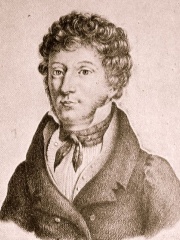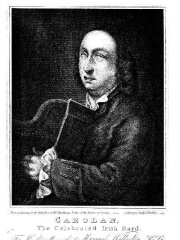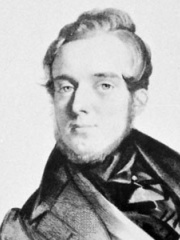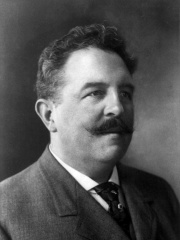




The Most Famous
COMPOSERS from Ireland
Top 6
The following people are considered by Pantheon to be the most legendary Irish Composers of all time. This list of famous Irish Composers is sorted by HPI (Historical Popularity Index), a metric that aggregates information on a biography's online popularity.

1. John Field (1782 - 1837)
With an HPI of 72.66, John Field is the most famous Irish Composer. His biography has been translated into 38 different languages on wikipedia.
John Field (26 July 1782 – 23 January 1837) was an Irish pianist, composer and teacher widely credited as the inventor of the nocturne. While many of his contemporaries wrote in a similar style, Field was the first to use the term to apply to a character piece featuring a cantabile melody over an arpeggiated accompaniment. Born into a musical family in Dublin, he received his early education in the city, particularly with Tommaso Giordani. The family moved to London in 1793 where, under the tutelage of Muzio Clementi, Field soon became a famous and sought-after concert pianist. Together, they visited Paris, Vienna, and Saint Petersburg. Ambiguity surrounds Field's decision to remain in the latter, but it is likely that Field acted as a sales representative for Clementi & Co.. Field was very highly regarded by his contemporaries and his playing and compositions influenced many major composers, including Felix Mendelssohn, Frédéric Chopin, Johannes Brahms, Robert Schumann, and Franz Liszt. Although little is known of Field's time in Russia, he undoubtedly contributed substantially to concerts and teaching, and to the development of the Russian piano school. Amongst his students were Charles Mayer, Alexandre Dubuque, and Antoine de Kontski.

2. Turlough O'Carolan (1670 - 1738)
With an HPI of 68.07, Turlough O'Carolan is the 2nd most famous Irish Composer. His biography has been translated into 25 different languages.
Turlough O'Carolan (Irish: Toirdhealbhach Ó Cearbhalláin [ˈt̪ˠɾˠeːl̪ˠəx oː ˈcaɾˠwəl̪ˠaːnʲ, - ˈcaɾˠuːl̪ˠaːnʲ]; 1670 – 25 March 1738) was a blind Celtic harper, composer and singer in Ireland whose great fame is due to his gift for melodic composition. Although not a composer in the classical sense, Carolan is considered by some to be Ireland's national composer. Harpers in the old Irish tradition were still living as late as 1792, and ten, including Arthur O'Neill, Patrick Quin and Donnchadh Ó hÁmsaigh, attended the Belfast Harp Festival. Ó hÁmsaigh played some of Carolan's music, but disliked it for being too modern. Some of Carolan's own compositions show influences of the style of continental classical music, whereas others such as Farewell to Music reflect a much older style of "Gaelic Harping".

3. Charles Villiers Stanford (1852 - 1924)
With an HPI of 60.49, Charles Villiers Stanford is the 3rd most famous Irish Composer. His biography has been translated into 31 different languages.
Sir Charles Villiers Stanford (30 September 1852 – 29 March 1924) was an Anglo-Irish composer, music teacher, and conductor of the late Romantic era. Born to a well-off and highly musical family in Dublin, Stanford was educated at the University of Cambridge before studying music in Leipzig and Berlin. He was instrumental in raising the status of the Cambridge University Musical Society, attracting international stars to perform with it. While still an undergraduate, Stanford was appointed organist of Trinity College, Cambridge. In 1882, aged 29, he was one of the founding professors of the Royal College of Music, where he taught composition for the rest of his life. From 1887 he was also Professor of Music at Cambridge. As a teacher, Stanford was sceptical about modernism, and based his instruction chiefly on classical principles as exemplified in the music of Brahms. Among his pupils were rising composers whose fame went on to surpass his own, such as Gustav Holst and Ralph Vaughan Williams. As a conductor, Stanford held posts with the Bach Choir and the Leeds Triennial Music Festival. Stanford composed a substantial number of concert works, including seven symphonies, but his best-remembered pieces are his choral works for church performance, chiefly composed in the Anglican tradition. He was a dedicated composer of opera, but none of his nine completed operas has endured in the general repertory. Some critics regarded Stanford, together with Hubert Parry and Alexander Mackenzie, as responsible for a renaissance in music from the British Isles. However, despite his conspicuous success as a composer in the last two decades of the 19th century, his music was eclipsed in the 20th century by that of Edward Elgar as well as former pupils.

4. Michael William Balfe (1808 - 1870)
With an HPI of 55.49, Michael William Balfe is the 4th most famous Irish Composer. His biography has been translated into 27 different languages.
Michael William Balfe (15 May 1808 – 20 October 1870) was an Irish composer, best remembered for his operas, especially The Bohemian Girl. After a short career as a violinist, Balfe pursued an operatic singing career, while he began to compose. In a career spanning more than 40 years, he composed at least 29 operas, almost 250 songs, several cantatas and other works. He was also a noted conductor, directing Italian Opera at Her Majesty's Theatre for seven years, among other conducting posts.

5. Victor Herbert (1859 - 1924)
With an HPI of 54.27, Victor Herbert is the 5th most famous Irish Composer. His biography has been translated into 21 different languages.
Victor August Herbert (February 1, 1859 – May 26, 1924) was an American composer, cellist and conductor of English and Irish ancestry and German training. Although Herbert enjoyed important careers as a cello soloist and conductor, he is best known for composing many successful operettas that premiered on Broadway from the 1890s to World War I. He was also prominent among the Tin Pan Alley composers and was later a founder of the American Society of Composers, Authors, and Publishers (ASCAP). A prolific composer, Herbert produced two operas, a cantata, 43 operettas, incidental music to 10 plays, 31 compositions for orchestra, nine band compositions, nine cello compositions, five violin compositions with piano or orchestra, 22 piano compositions and numerous songs, choral compositions and orchestrations of works by other composers, among other music. In the early 1880s, Herbert began a career as a cellist in Vienna and Stuttgart, during which he began to compose orchestral music. Herbert and his opera singer wife, Therese Förster, moved to the U.S. in 1886 when both were engaged by the Metropolitan Opera. In the U.S., Herbert continued his performing career, while also teaching at the National Conservatory of Music, conducting and composing. His most notable instrumental compositions were his Cello Concerto No. 2 in E minor, Op. 30 (1894), which entered the standard repertoire, and his Auditorium Festival March (1901). He conducted the Pittsburgh Symphony from 1898 to 1904 (taking over from founding conductor Frederic Archer) and then founded the Victor Herbert Orchestra, which he conducted throughout the rest of his life. Herbert began to compose operettas in 1894, producing several successes, including The Serenade (1897) and The Fortune Teller (1898). Some of the operettas that he wrote after the turn of the 20th century were even more successful: Babes in Toyland (1903), Mlle. Modiste (1905), The Red Mill (1906), Naughty Marietta (1910), Sweethearts (1913) and Eileen (1917). After World War I, with the change of popular musical tastes, Herbert began to compose musicals and contributed music to other composers' shows. While some of these were well-received, he never again achieved the level of success that he had enjoyed with his most popular operettas.

6. Michael McGlynn (b. 1964)
With an HPI of 24.41, Michael McGlynn is the 6th most famous Irish Composer. His biography has been translated into 5 different languages.
Michael McGlynn (born 11 May 1964) is an Irish composer whose choral music has been the subject of sustained academic analysis for its fusion of medieval, Irish traditional, and contemporary musical elements. Scholarly studies describe his compositional language as characterised by modality, drones, open sonorities, parallel motion, and rhythmic development through repetition, frequently engaging with Irish-language texts and concepts of landscape, ritual, and cultural memory within contemporary Irish art music. His work has been discussed in academic literature on Irish choral nationalism and the transmission of cultural ethos through composition. McGlynn is the founder and artistic director of the vocal ensemble Anúna, established in 1987, through which many of his works have been premiered and recorded, and which has maintained a long-standing international performance and recording profile.
People
Pantheon has 6 people classified as Irish composers born between 1670 and 1964. Of these 6, 1 (16.67%) of them are still alive today. The most famous living Irish composers include Michael McGlynn. The most famous deceased Irish composers include John Field, Turlough O'Carolan, and Charles Villiers Stanford.
Living Irish Composers
Go to all RankingsDeceased Irish Composers
Go to all RankingsJohn Field
1782 - 1837
HPI: 72.66
Turlough O'Carolan
1670 - 1738
HPI: 68.07
Charles Villiers Stanford
1852 - 1924
HPI: 60.49
Michael William Balfe
1808 - 1870
HPI: 55.49
Victor Herbert
1859 - 1924
HPI: 54.27
Overlapping Lives
Which Composers were alive at the same time? This visualization shows the lifespans of the 4 most globally memorable Composers since 1700.

